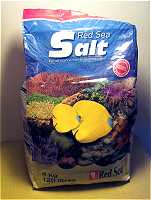|
3) Growing in seawater
Japanese studies, as well as numerous breeding reports from all around the world, show that Caridina Japonica larvae need to grow in 17ppm brackish water, and any salinity above 30 will kill them. On the contrary, my attempts at 17 ppm were a failure and the only way I seem to succeed is with a 34ppm salinity. A lot of people seem to be in a similar case, so I suggest you try both salinity levels in order to determine which one suits your shrimps' larvae.
Until recently, I used a very progressive method for putting the larvae into salt water by gradually increasing the salinity, but it turned out that it was useless, since the larvae can go directly into seawater without any problem !
So I just prepare a couple of Liters of seawater of double salinity (66p/68 ppm, vent it for 24h before using it) that I mix together with the fresh water containing the larvae (make sure to mix equal parts of salt and fresh water in order to obtain the desired salinty (33/34 ppm). The zoes are now in seawater, so I pour them directly into the breeding tank, in which the water has become a dark greenish mass.
|
About seawater and cooking salt :

I advise you to use a commercial salt especially meant for marine aquaria, no matter the brand. Some people have succeeded by using mere cooking salt, but I don't recommend you to do the same, for a few reasons.
First, here is the average composition of sea water (in the most present minerals) :
|
| g per litre |
| g per litre |
| chloride (Cl) |
18,9 |
bromide (Br) |
0,067 |
| sodium (Na) |
10,8 |
carbon (C) |
0,028 |
| magnesium (Mg) |
1,29 |
strontium (Sr) |
0,0079 |
| sulfate (SO4) |
2,7 |
boron (B) |
0,0045 |
| calcium (Ca) |
0,412 |
silicium (Si) |
0,003 |
| potassium (K) |
0,40 |
Fluoride (F) |
0,0013 |
you can notice that iodine, a famous constituent of seawater, is not in this table, for its level is way too low (50µg per litre).
Marine commercial salt is obtained by the complete evaporation of seawater, or any other process, which aims at obtaining a mix of all the minerals, and in exactly the same proportions, that are contained in sea water. On the other hand, Cooking salt is obtained by successive stages of evaporation, aiming at obtaining, in the end, the purest sodium-chloride possible, which is then highly enriched with iodine and fluoride for human consumption. Thus cooking salt could not be farther in its chemical composition from sea water. So if you try to make sea water with this salt, you'll get a water not only lacking
bromine, strontium, boron, and silicium, but also with abnormally high levels of iodine, fluoride, and potassium. I'm not sure it would be very harmful for the shrimps, but I prefer playing it the safe way : living organisms need the same conditions as in their natural habitat, or else reef aquarist would all be using cooking salt !
| |
|
Watch out for water evaporation : the seawater tank must be permanently covered with a glass or acrylic plate, so as to minimize water evaporation and too great a change in salinity.
| |
4) The growth of the zoes :
Here are a few shots of larvae at various stage of their growth in sea water :
The larvae spend about a month in sea water, the first metamorphoses into juveniles occuring at the 25th day, and the last ones around the 40th day. That's really fast compared to some other breeders who report up to 2 months in salt water, and also considering the fact that I put no additional food into the water !
|
Food :
The marine phytoplankton I use is by far the most convenient way to feed the larvae, in terms of yield and water pollution : I put the emphasis on this particular point because, after putting the larvae in the salt water tank, all I have to do is watch them grow with my arms crossed.
A few times a day, I use a spoon to slowly stir the water, thus mixing up particles of all sizes, formed of congregated algae, that accumulate on the bottom. I clearly see the larger zoes grab some of the particles to feed on them. This clearly illustrates that the phytoplankton is able to provide food to the smallest as well as to the biggest larvae.
You can try any other way of feeding them : it may work, but it will be much less convenient (you'll have to uncross your arms!), and will eventually produce a less satisfactory result.
My phytoplankton is Dunalliela Salina, but I think any kind of marine phytoplankton suitable for artemia breeding will do (eg. Thallassiosera Pseudomonas).
I cannot guarantee that this phytoplankton-based breeding method would work with a 17ppm salinity level, I haven't been able to grow my plankton in brakish water, but if one of you succeeds with another species of plankton, I'll be glad to hear of it !
| |
|
| |

